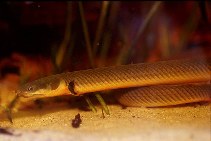| Distribution: |
Africa: coastal species, inhabiting river estuaries from Ouémé River in Benin to Sanaga River in Cameroon (Ref. 53784, 81628). Also reported from the Chiloango River (Ref. 1878, 2835, 3188, 42870, 43033, 81263), but this record needs confirmation and needs to be supported by additional material evidence (Ref. 53784, 81628). |
| Diagnosis: |
Dorsal spines (total): 7-13; Dorsal soft rays (total): 0-0; Anal spines: 0-0; Anal soft rays: 9-14; Vertebrae: 110-113. Diagnosis: The dorsal fin is composed of a series of well-separated spines each supporting one or several articulated rays and a membrane (Ref. 42791). Erpetoichthys calabaricus is distinguished from all Polypterus species by its very elongated, anguilliform body and the absence of ventral fin and subopercle (Ref. 2835, 42768, 81263).
Description: Body extremely elongate and anguilliform; subcylindrical, the height of which is comprised up to 24 times in standard length and head length 11 to 14 times in standard length (Ref. 2835, 42768, 42908, 81263, 81628). Head without subopercle, very faintly flattened, 1,6 to 2 times longer than broad; upper jaw prominent (Ref. 2835, 42908, 81263). Eye lateral, its diameter comprised 7,5 to 8,5 times in head length (Ref. 2835, 81263, 81628). Pelvic fins and girdle absent (Ref. 81628). Dorsal fin with 7-13 fin rays, largely separated from the others; anal fin with 9-14 rays; ventral fin absent (Ref. 2835, 42908, 81263, 81628). Body covered with rhombic ganoid scales (Ref. 42791): 106-114 in lateral line, 30-34 around body, 28-33 predorsal scales, 48-51 prepelvic scales; lateral line scales simply perforated (Ref. 2835, 42908, 81263, 81628).
Colouration: In alcohol, colour is uniformly olive brown on the back and upper part of the flanks, whitish to beige on belly (Ref. 2835, 81263, 81628). A broad dark spot on pectoral fins, extending almost to the tip of the fin rays (Ref. 2835, 81263, 81628). |
